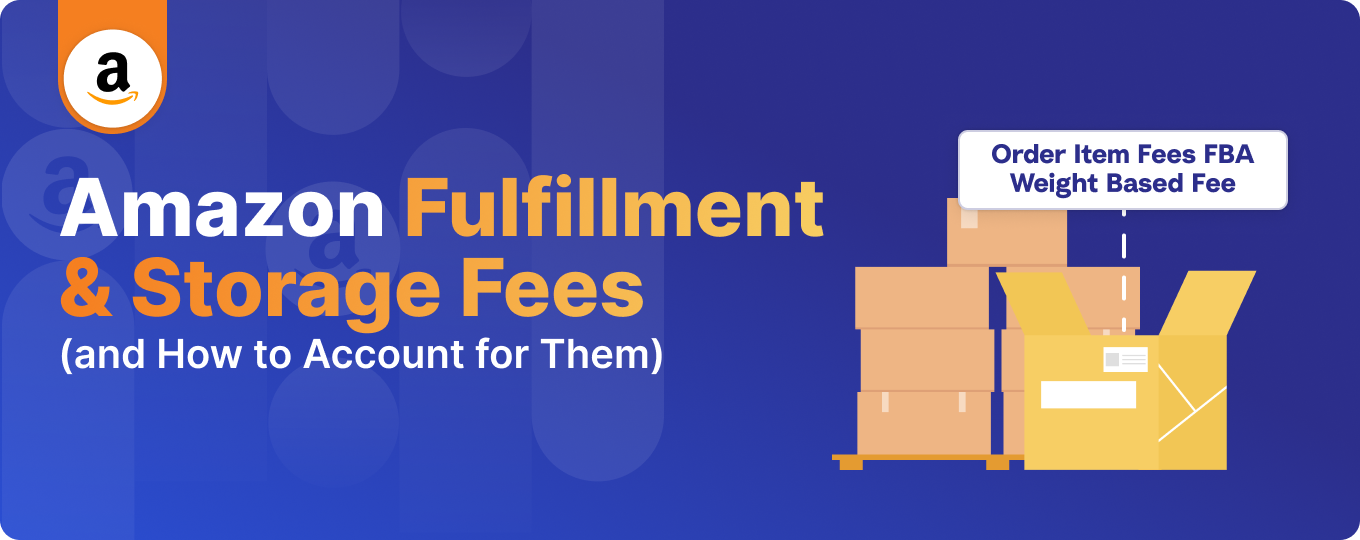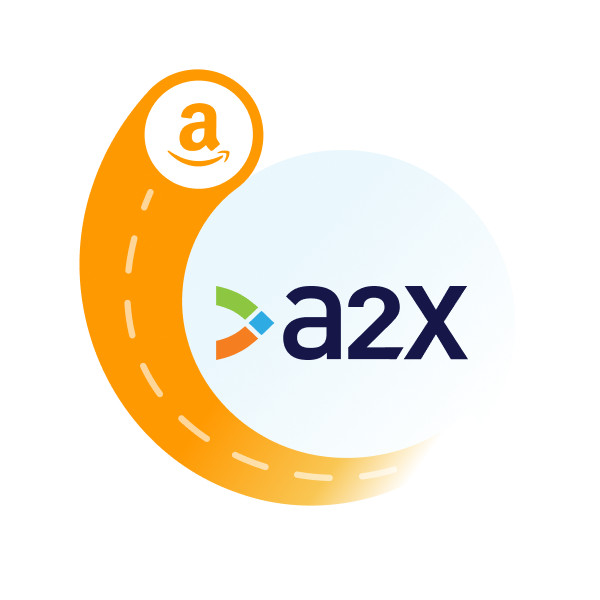Amazon Fulfillment and Storage Fees (and How to Account for Them)
Written by: Elspeth Cordray

At the center of Amazon’s services for sellers is the Fulfillment by Amazon (FBA) program. By using FBA, sellers can store their products in Amazon’s fulfillment centers, and Amazon takes care of storage, packing, and shipping.
Being part of the FBA program means access to Amazon’s shipping and distribution infrastructure, potentially making shipping faster and more efficient. Plus, products can also become eligible for Amazon Prime, which can significantly increase sales potential.
But, the convenience and benefits come at a cost. Selling on Amazon means paying a variety of fees that span across the entire selling process.
One category of costs that FBA sellers should have a deep understanding of are Amazon fulfillment and storage fees. Having a grasp of these fees (in context with the other fees you might be charged) will help you understand how they impact the overall profitability of your store, and where you can potentially make changes.
Read on to understand what fulfillment and storage fees include, how they show up on your Amazon seller statement, how you can account for them, and more.
Key takeaways:
- Amazon FBA sellers incur two primary types of fees: fulfillment fees (covering the costs of picking, packing, and shipping items, calculated based on size and weight) and storage fees (based on the space inventory occupies in Amazon’s warehouses). Storage fees can vary seasonally and may include long-term storage charges for slow-moving inventory.
- The impact of fulfillment and storage fees depends on product type and sales patterns. For instance, lightweight electronics have lower fulfillment fees but may accumulate storage costs if stock lingers. Large appliances incur higher fulfillment fees due to size, while seasonal products like Halloween costumes may lead to higher storage fees if not sold quickly.
- Properly accounting for Amazon fees is crucial for accurate profit calculation, inventory management, and business growth. Tools like A2X automate fee tracking and reconciliation with accounting software, ensuring sellers have clear visibility into their expenses. Sellers can also reduce costs by optimizing inventory levels, streamlining packaging, and leveraging Amazon’s fulfillment strategies.
What are Amazon fulfillment and storage fees?
Amazon fulfillment and storage fees are specific costs that Amazon charges its sellers who use the Fulfillment by Amazon (FBA) program. These fees are separate from other seller fees that Amazon might charge, such as referral/commission fees or subscription fees. Here’s a breakdown:
Amazon fulfillment fees: These are fees associated with picking, packing, and shipping your products when a customer places an order. The cost is primarily determined by the size and weight of the item(s) being sold.
Amazon storage fees: These fees are charged based on the amount of space your inventory occupies in Amazon’s warehouses. There are a couple types of storage fees:
- Monthly storage fees: Calculated based on the volume (in cubic feet) of products stored in Amazon’s fulfillment centers. The fees can vary based on the time of year, with higher fees typically charged during the peak holiday season.
- Long-term storage fees: If items remain in Amazon’s warehouses for longer than 365 days, additional long-term storage fees may be applied. These fees are intended to encourage sellers to keep their inventory levels in check and to avoid clogging up warehouse space with slow-moving items.
As mentioned, these fees can vary depending on the nature of the sale, the weight and size of the product, and the chosen delivery speed. For example:
- Small electronics: If you’re selling a lightweight electronic gadget like a smartwatch, the fulfillment fee for this might be relatively low due to its size and weight. However, if you’re storing large quantities over an extended period, storage fees can add up.
- Large home appliances: Selling a larger item, such as a refrigerator, would result in a much higher fulfillment fee due to its size and weight. If these items are slow-moving, the long-term storage fees can significantly affect profit margins.
- Seasonal items: Selling Halloween costumes might result in increased storage fees during off-peak months, as these items are typically in demand for a short period each year.
There are also fees associated with inbound transportation and disposal of inventory, if necessary:
- Delivery and transport fees: Fees related to sending inventory to Amazon’s warehouses for storage. See Delivery and Transport Fees (and How to Account for Them) for more information about this.
- Removal and disposal fees: If you need to dispose of inventory (e.g., if you sell food products that have expired), Amazon may charge a fee. Similarly, if you need to remove inventory, removal fees are usually charged per item removed.
Learn more about Amazon FBA fees on Amazon’s website.
Examples of fulfillment and storage fees
As with many other Amazon transaction categories, fulfillment and storage fees will show up on your Amazon seller statement under a variety of line items, such as:
Order Item Fees FBA Per Order Fulfillment Fee | An FBA fee charged per order, calculated based on the dimensions and weight of the total order. |
Order Item Fees FBA Per Unit Fulfillment Fee | An FBA fee charged per unit, based on the dimensions and weight of each individual item. |
Order Item Fees FBA Weight Based Fee | An FBA fee calculated based on the weight of each order item. |
Non-Amazon Order Item Fees FBA Per Order Fulfillment Fee | An FBA fee for non-Amazon items, charged per order and based on total order dimensions and weight. |
Non-Amazon Order Item Fees FBA Per Unit Fulfillment Fee | An FBA fee for non-Amazon items, charged per unit. |
Non-Amazon Order Shipment Fees FBA Transportation Fee | An FBA transportation and shipment fee for the total non-Amazon order. |
Other Transaction Storage Fee | A fee for Amazon's storage services for products. |
Other Transaction Storage Renewal Billing | Recurring storage charges in Amazon's FBA centers, including monthly costs and additional fees for long-term storage. |
Other Transaction Removal Complete | A fee per item for removal services, typically completed within 14 business days and reflected in the 'Payments' report. |
Other Transaction Disposal Complete | A fee charged by Amazon for disposing of unsold or expired inventory, which sellers can opt for instead of self-disposing. |
“Non-Amazon” transactions refer to products that are sold by third-party sellers through channels other than the Amazon marketplace. These could include items sold on the seller’s own website, another online marketplace, a physical retail location, or through any other sales channel that is not directly operated by Amazon.
Be sure to consult Amazon for additional information about specific fees that might be applicable to your store.
Why does accurate accounting for fulfillment and storage fees matter?
It can be tempting for sellers to avoid learning the costs of running their business. After all, accessing and analyzing accounting data can take time (especially if you’re not using the right tools, like A2X!). Or, maybe you accept whatever your fees and expenses are so you can ensure quick delivery and greater customer satisfaction.
However, the benefits of accurately accounting for all your store’s transactions can massively outweigh the costs of ignoring your numbers. A few of these benefits include:
- Profit calculation: Without accounting for these fees, sellers might overestimate their profit margins. Recognizing these costs can help you price products appropriately to maintain desired profitability.
- Inventory management: Keeping tabs on storage fees helps with efficient inventory management, which could allow you to avoid unnecessary long-term storage fees for slow-moving items.
- Business growth: Accurate accounting provides a clear picture of your business expenses, which can help you make informed decisions about growth and expansion.
Accounting for Amazon fulfillment and storage fees using A2X
If you’ve ever tried to manually review your Amazon seller statement and input the transactions into your accounting software, then you know that this is a daunting and time-consuming task.
Fortunately, A2X can make this easy. A2X acts like a bridge between Amazon Seller Central and your accounting software, allowing you to quickly, easily and accurately complete your Amazon bookkeeping.
Watch this video to learn how A2X works:
Follow the steps below to set it up.
1. Sign up for A2X
If you haven’t already, sign up for A2X.
Connect your accounting software (e.g., QuickBooks Online or Xero). Then, connect to your Amazon Seller Central account.
2. Map your Amazon transactions
Click on ‘Accounts and Taxes’. This brings you to the Account and Tax Mapping page, which is where you can allocate Amazon transaction types to the correct accounts in your accounting software.
A2X will help you set up your account mapping. Follow the prompts to answer the questionnaire, then choose the ‘Default’ setup option to automatically set these up. (If you want to change any of A2X’s default mappings, you can update this after the default setup is complete.)
Here’s how A2X would typically map the example fulfillment and storage fees that we provided earlier. Important: We recommend working with a specialized ecommerce accountant to make sure you have mapping set up correctly for your specific business needs.
Fee name | A2X Default Account | Account Type |
Order Item Fees FBA Per Order Fulfillment Fee | Amazon FBA Fees | Expense |
Order Item Fees FBA Per Unit Fulfillment Fee | Amazon FBA Fees | Expense |
Order Item Fees FBA Weight Based Fee | Amazon FBA Fees | Expense |
Non-Amazon Order Item Fees FBA Per Order Fulfillment Fee | Amazon FBA Fees | Expense |
Non-Amazon Order Item Fees FBA Per Unit Fulfillment Fee | Amazon FBA Fees | Expense |
Non-Amazon Order Shipment Fees FBA Transportation fee | Amazon FBA Fees | Expense |
Other Transaction Storage Fee | Amazon FBA Fees | Expense |
Other Transaction Storage Renewal Billing | Amazon FBA Fees | Expense |
If you’re selling on multiple marketplaces in different countries, you might also see a country or marketplace breakdown of your data.
3. Review & post your settlements
Click on ‘Settlements’ in A2X. Here, you’ll find a list of settlements that A2X has fetched from Amazon.
Click ‘Review’ to see the details of the settlement, including the mapping details. If everything looks good, click ‘Send to [Your Accounting Software]’ to post the settlement.
4. Reconcile in your accounting software
Once you’ve posted your settlement to your accounting software, locate it in the bank feed. The amount should match the Amazon deposit in your bank feed, and it’s ready to be reconciled.
5. Automate and stay up-to-date
Regularly check A2X for new settlement reports following the close of each settlement cycle on Amazon. Carefully review each settlement, then post to your accounting system and reconcile.
Looking to save even more time? Consider enabling A2X’s Auto-Posting feature once you’re confident using A2X – it will allow settlements to be automatically posted without your review.
Ways to manage fulfillment and storage fees
Accurate and up-to-date accounting for your Amazon store will give you the data you need to reach your business’s financial goals.
Using a tool like A2X to capture and categorize your Amazon fees will ultimately allow you to look at the expenses listed on your Profit and Loss report and make some decisions about how to potentially cut costs.
For example, when it comes to fulfillment and storage fees, you could explore:
- Streamlining packaging and inventory: Compact and secure packaging reduces dimensional weight fees, while a robust inventory management system, including just-in-time restocking and the utilization of Amazon’s Inventory Placement Service, could help avoid unnecessary storage fees.
- Introducing seasonal and multi-channel strategies: Adjust inventory before high-fee periods, like the holiday season, and use Amazon’s Multi-Channel Fulfillment to maintain faster turnover rates across various selling platforms.
- Analyzing your Amazon: Stay on top of FBA fee changes and be aware of programs like Low-Price FBA fees for eligible items to lower costs.
Using tools like A2X can help you to keep close tabs on your Amazon FBA fees, so you can maximize your Amazon store’s profits.
Amazon accounting is easy with A2X
Better business financials don’t have to involve complicated and time-consuming processes! Sign up for a free trial and integrate A2X with QuickBooks Online or A2X with Xero today!
Learn more about Amazon seller fees and transactions and how to account for them:
- Amazon Order Revenue Transactions (and How to Account for Them)
- Amazon Delivery and Transport Fees (and How to Account for Them)
- Amazon Commission and Selling Fees (and How to Account for Them)
- Amazon Subscription Fees (and How to Account for Them)
- Amazon Reserve Balances (and How to Account for Them)
- Amazon Reimbursements (and How to Account for Them)

Integrate Amazon and your accounting software for accurate accounting
A2X auto-categorizes your Amazon sales, fees, taxes, and more into accurate summaries that make reconciliation in your general ledger a breeze.
Try A2X today
